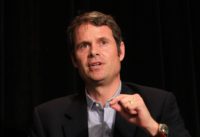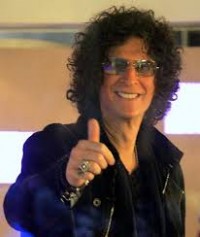 Sometimes we get so deeply ensconced in our everyday media worlds that we lose sight of just how far and fast it’s all been moving. That’s why we value historians who spend time, energy, and thought studying trends, change, and transformations.
Sometimes we get so deeply ensconced in our everyday media worlds that we lose sight of just how far and fast it’s all been moving. That’s why we value historians who spend time, energy, and thought studying trends, change, and transformations.
A guy who truly fits the bill is Matthew Lasar, author, educator, and observer of the radio world around him. He is managing editor of the Radio Survivor blog, and teaches history at the University of California at Santa Cruz. His new book, Radio 2.0: Uploading the First Broadcast Medium, is a study of the changing audio world around us.
It’s ironic in a way that one of the wisest observers of some of these macro technological trends, Alvin Toffler, passed away late last month. He was a true futurist, and the author of Future Shock, a book written back in 1970 that predicted many of the changes that were about to come and why they would present challenges to society. To a great degree many of us have been suffering from “future shock” as we try to navigate the changing technological waters in our own jobs and careers.
Matthew Lasar is helping us predict the future, by making us aware of the past. In today’s “Guest List,” he takes an historical look at six transformative Internet radio moments we’ve been witness to over these past couple decades, and why they’re important as we carom forward. As we continue to try to make sense of the changing media landscape around us, having historical perspective become an important tool. – FJ
The history of radio broadcasting in the United States is replete with timelines highlighting key moments in the saga. Every radio history buff can recite them chapter and verse, from KDKA of Pittsburgh announcing national election results in 1920 through NPR kicking off its first edition 51 years later.
But what about the last twenty years of radio history? Suddenly we are lost in a vast sea of innovations that arrive with a rapidity unknown to previous generations. There are no canonical events to fall back on. Given the plethora of digital technologies that claim the title, the very definition of “radio” is up for grabs. Nonetheless, here are five pivotal moments that I identify in my new book, Radio 2.0: Uploading the First Broadcast Medium.
 1. 1993: Carl Malamud launches “Internet Talk Radio.”
1. 1993: Carl Malamud launches “Internet Talk Radio.”
Who knew that one of the first ‘Net-based radio shows would be rolled out by an economist who had helped develop a computer networking system for the Federal Reserve’s Board of Governors, but there it was. Malamud’s ITR show surfaced as the World Wide Web was just getting underway. Listeners could download files or play them on the web’s predecessor, a USENET list.
Proudly nerdy, Malamud’s program featured a “Geek of the Week” segment about some software innovation. But what made his offering most prescient was how he described it, as “asynchronous radio” for “asynchronous times.” In other words, from the get-go much Internet/digital radio was, unlike its AM/FM cousin, all about being on-demand.
2. 1995: The MP3 file gets its name.
Back in the 1980s a doctoral student named Karlheinz Brandenburg set out to fulfill the dream of his mentor, a telephone accessible database of digital songs. The problem: the size of most digital formats made this unworkable. Brandenburg ingeniously solved the dilemma with a compression system that discarded sounds mostly inaudible to the human ear. In 1992, the solons of the Motion Picture Experts Group met and pronounced his offering good, naming it MPEG 1-Audio Layer 3. Three years later this clunky moniker was shortened down to “MP3.” By 1999, MP3 was the second most searched-for term on the ‘Net, the first being “sex.”
3. 1997: Winamp arrives on the market.
As MP3 files proliferated, the question of how to play them loomed large. Enter Justin Frankel, a laid back college dropout and “dude speak” teenager, in the words of one journalist. Disappointed in the playback abilities of extant Windows audio players, he cooked up “Winamp.”
The application pointed to the digital future, but visually harkened back to the cassette player past with its “prev,” “play,” “pause,” “stop,” and “next” buttons. Winamp allowed users to design their own “skins” for the app. Suddenly they morphed into futuristic insects, grungy boom boxes, and Pikachu shrines. More importantly, Winamp could easily adapt to the plethora of live streaming protocols that emerged, most notably Frankel’s own SHOUTcast streaming system.
4. 2000: Tim Westergren sets out to create Pandora.
A Jazz musician by training, Westergren began thinking about developing what became Pandora while writing music scores for films. His work  with directors often involved following vague instructions such as “Something like Natalie Merchant, but more scary.” Surely there was a better way to grow the precise musical tastes of others, he thought.
with directors often involved following vague instructions such as “Something like Natalie Merchant, but more scary.” Surely there was a better way to grow the precise musical tastes of others, he thought.
Out of this need came his first company, Savage Beast Technologies, mother to the Music Genome Project. The Project divided each song into a host of attributes, tracked the affinities of listeners for these traits, and gave them more of what they wanted. Taking advantage of a cascade of new audio compression standards, Pandora launched as a website in 2005. Six years later it had 60 million registered users.
5. 2004: Ben Hammersley coins the term “podcasting.”
The columnist was busy finishing up a piece for The Guardian about a new trend in the online world: people recording themselves and then uploading the audio for automated download by their audience later on. But Hammersley couldn’t figure out what to call the phenomenon. He kept coming up with new monikers: Audioblogging? GuerillaMedia?
It was a tribute to Apple Computer that the term that stuck, “podcasting,” referred to its most popular product, the iPod. As Hammersley’s column went to print, the iTunes Store approached its 50 millionth downloaded song. Within a year, podcasting represented a dynamic new way for musicians, comedians, and opinionators to share their art and ideas.
6. 2006: Howard Stern leaves FM to join Sirius satellite radio.
By the second half of the first decade of the 21st century, Howard Stern’s passionate relationship with traditional broadcasting had soured. His overseers were coughing up record indecency fines to the Federal Communications Commission for gags like a fake ad for “Sphincterine” (in the FCC’s own words “a purported personal hygiene product designed for use prior to sexual activity.”). Enough was enough, Stern declared. “I have let myself get so beaten down by the FCC,” he lamented. “I’ve become accustomed to their abuse, like a battered wife.” Now he saw the way out, a $500 million contract with Sirius, free from the Commission’s indecency rules. “This is a watershed event for the industry,” Sirius  CEO Joseph Clayton proclaimed. “It establishes Sirius Satellite Radio as the successor to FM much the same way FM replaced AM.”
CEO Joseph Clayton proclaimed. “It establishes Sirius Satellite Radio as the successor to FM much the same way FM replaced AM.”
Speaking as an Internet/digital radio historian, I would not go that far. But the Stern/Sirius transition sent a strong signal that a new landscape had constructed itself around the hallowed world of AM/FM, one big enough to provide a home for mega-entertainers like Howard Stern. “Radio” was still very much about analog broadcasting, but now it was also about Pandora, YouTube, podcasting, Spotify, SoundCloud, digital formats like HD and DAB, and a host of other innovations supported by global social networking systems like Twitter and Facebook.
The aforementioned are some of my pivotal moments in this story. I look forward to learning about yours.
Thanks to Seth Resler for putting together this week’s “Guest List.”
More info on Matthew Lasar’s Radio 2.0: Uploading The First Broadcast Medium here.
More Guest Lists
- Jamie Michelson: 5 Reasons Why I’m Still Loyal To Radio
- James Cridland: 5 Countries You Should Look At For Radio Ideas
- Jeff Gilbert: Five Things I’ve Learned About Cars…And Radio
- Georgia Beasley: 5 Things Radio Managers Should Know About Millennials
- Rob Kass: 5 Things Every Radio Professional Should Know About Nielsen’s SDK
- What To Do If Your Radio Station Goes Through A Midlife Crisis - April 25, 2025
- A 2020 Lesson?It Could All Be Gone In A Flash - April 24, 2025
- How AI Can Give Radio Personalities More…PERSONALITY - April 23, 2025





A very good report on specific events leading up to today. I would argue though that we in the USA would not have made the most important migration of all…AM to FM without the story of AM.
Why because FM has not migrated in my view to internet webcasting like they did back in the late 60’s.
Lastly, the only other famous group to gather in a very large crowd in NYC was The Beatles. The only other person to do that was Howard love him or hate him Stern.
Otherwise a great article. I am a radio freak just like you and Fred. Well done..i will read your blog too. Thanks for reading…..Sid.
Sid, thanks for the kind note and the observations. Our mission is to stimulate thinking with our blog, and it looks like we hit goal.
Didn’t you just retell Wikipedia?
Well, I hope it ran deeper than that. Matthew gave perspective and commentary, so I hope there was more meat on the bone than what you read in Wikipedia.